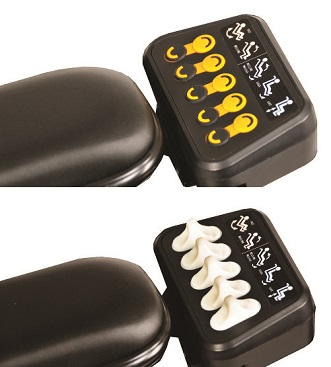Power seating functions such as tilt, recline, seat elevate, and elevating leg rests provide users with improved positioning, the opportunity to redistribute pressure, and an increased level of independence. However, no matter how beneficial the power seating functions may be, if he/she cannot independently and quickly operate the control device it greatly decreases the odds that the user will utilize the power seating functions.
Operation of power seating functions are commonly controlled through the joystick; the user utilizes the joystick to scroll through a menu, selects the desired seat function, and is then able to make the seating adjustments by shifting the joystick. This multi-step process may be difficult for clients with fine motor limitations and/or cognitive impairments. In addition a user may report scrolling through the menu is simply not fast enough. The good news is there are a variety of options available to make power seating functions more accessible.
Programmable Buttons
The programmable buttons feature enables the re-assignment of buttons on joysticks. When using programmable buttons, select buttons are designed to be programmed as shortcut keys and other buttons can support up to two features. For example, the speed up button could also be programmed as tilt up. The second feature is controlled by time and will engage when the button is held down longer than the programmed second function time. Programmable buttons provide users with quick and direct access to seat functions without having to add additional equipment.
Switches
If using programmable buttons on the joystick is not the ideal option for a client, separate switches can be utilized for accessing power seating functions by assigning the switch jacks on the joystick to perform a specific function. There are numerous options of mechanical and electronic switches available on the market today. To learn more about switches be sure to check out our recent post "Mechanical vs. Electronic Switches: What are the primary differences?"
Ctrl+5
Some users may benefit from using a completely separate module for accessing their power seating functions. The recently launched Ctrl+5 offers five sets of switches that can be programmed to control features on the power wheelchair including powered seating functions, modes, profiles, speeds, lights, and horn. The freedom of utilizing a separate module such as the Ctrl+5 means it can be mounted in three different locations (arm pad, power recline rail, or on the back as an attendant control). The Ctrl+5 also features a USB port that is ideal for charging personal technology devices such as a phone or tablet.
The Ctrl+5 is available in two different styles, Button (top image) and Toggle (bottom image):

All of the solutions discussed in this article are available on select models of Quickie and Zippie power wheelchairs. To learn more, visit the power wheelchairs product pages, contact your authorized Sunrise Medical supplier, reach out to your local Sunrise Medical account manager, or call our customer service department.
Thank you for reading our blog! We love hearing from you, so please do not hesitate to reach out to us. We encourage you to leave a comment or send us an email at NAMarketing2@sunmed.com.
Always remember at the end of the day, your client is your number one priority!
- Angie
Follow Angie on Twitter @ATigerKiger